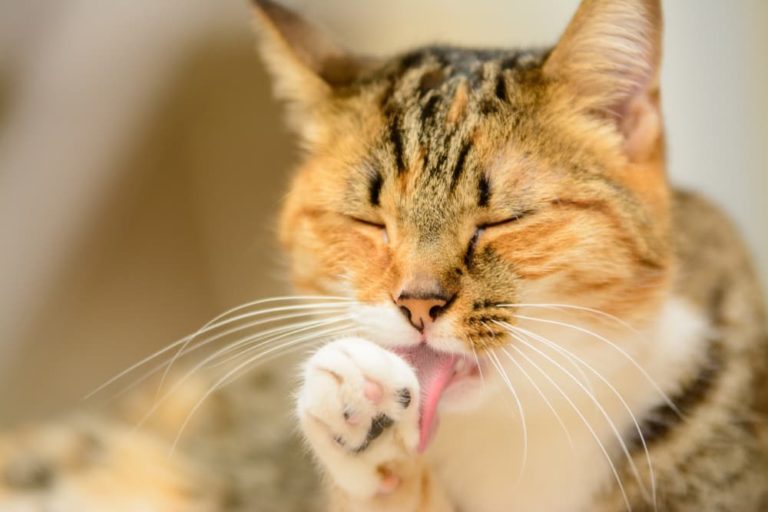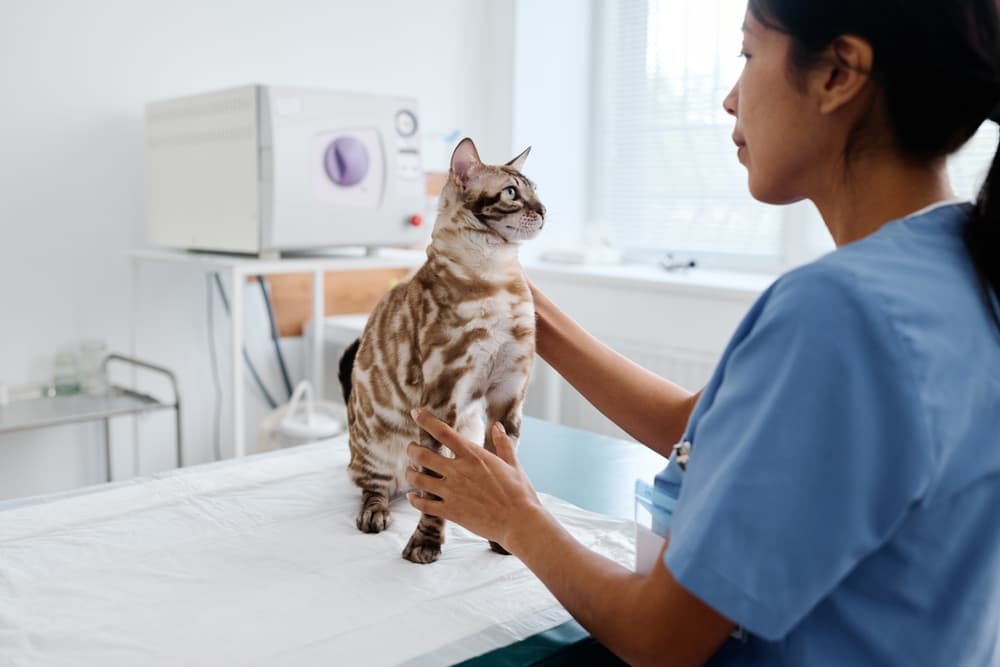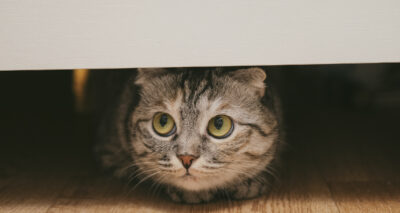Cat Overgrooming: Why it Happens and What to Do

Cats are excellent self-groomers. So excellent, in fact, that they don’t need to take baths with water. Their tongues are rough like bristles on a brush, and they typically spend nearly half the time they are awake grooming themselves!
So, if grooming is such a normal behavior for cats, why do some cats groom too much? And how do you know if your cat is grooming too much? Read on for everything you need to know about cat overgrooming, including why it happens, what signs to look for, and how to handle it.
Excessive Grooming in Cats: How Much Is Too Much?
Grooming is essential for cats to maintain skin health, remove shedding fur, get rid of parasites like fleas, and cool off. Cats will groom by licking, chewing, and nibbling on themselves. They use their paws and tongues, contorting their bodies into many different poses to reach every square inch. Cats may focus on one area of the body or cover the entire body head to toe. When grooming each other, cats tend to focus on the head and neck – the hardest places to reach themselves.
Cats groom approximately 15 percent of each day, which equates to an average of 4 minutes every hour. Exactly when or how frequently they choose to groom themselves varies from cat to cat, and when they become dirty, they groom for longer.
Most cats groom after resting and eating. Cats will also groom immediately after stressful situations – when they get scared, they’ll run off, suddenly stop, and furiously but briefly lick themselves. This could be a way of trying to calm down.
Overgrooming is essentially when cats groom so much that they remove healthy fur. This results in alopecia, or abnormal fur loss. The fur loss may cause your cat to be completely bald, develop bald patches, or have an unusually thin fur coat through which you can see skin. Because a lot of the excessive grooming can occur in secret, most cat parents don’t realize they have an overgrooming cat until fur is missing.
Cat Overgrooming: Why It Happens
Around 75 percent of cats with overgrooming issues have underlying medical conditions. Only 10 percent of cats overgroom strictly due to behavior, while the rest of the population (around 15 percent) have both medical and behavioral concerns [1]. All in all, if your cat is overgrooming, there’s most likely a medical cause.
There are three general causes of cat overgrooming:
- Painful conditions. Any source of pain or discomfort could lead to cat overgrooming. Conditions such as bladder inflammation (cystitis), back pain, or full anal sacs have led to overgrooming. Cats may overgroom in specific areas depending on where the discomfort is coming from.
- Pruritus (itchiness). Parasites like fleas, skin infections with bacteria or a fungus, or an allergy to something results in overgrooming. Allergies or hypersensitivity can include fleas, food, or environmental, such as pollen or dust.
- Psychogenic (behavior-related and not medical) issues. Stress can lead to overgrooming, and it can be caused by an ongoing issue like fights between cats or be triggered by something specific, such as the addition or loss of a person (or animal) in the home. With some medical conditions (i.e. hyperthyroidism), cats can be hyperactive, which also leads to overgrooming. Siamese cats and other Asian breeds, such as Himalayan cats, are more likely to overgroom for psychogenic reasons.
Signs of Overgrooming in Cats
Cats who are overgrooming for medical reasons do not have a typical pattern but may focus on a painful area. Cats who are overgrooming for psychogenic reasons typically overgroom their sides, often symmetrically.
Signs of overgrooming are different for each cat but can include:
- Complete fur loss or baldness anywhere on the body
- Thinning fur coat
- Redness or crusts on the skin
- Tufts of fur found near your cat’s resting areas
- Less or more activity
- Decreased or increased appetite
Cat Overgrooming Treatment

Pet parents must seek veterinary help to identify and manage the underlying cause of cat overgrooming. Even if your cat is not damaging his skin to the point of needing immediate medical care, it shows that your cat is uncomfortable and should be treated.
Veterinarians will do a thorough exam and recommend testing of both the skin and your cat’s overall health. Looking at fur or a skin scrape sample under the microscope can identify mites, lice, or ringworm. Doing blood and urine testing will screen for underlying medical causes for pain or discomfort.
If your cat has an allergy, testing for what they’re allergic to can be challenging to interpret. Most cats with allergies go through a food trial, meaning they eat a prescription diet that only has one animal source as the protein for at least two months with no treats, no people food, and no other cat foods. Antihistamines like cetirizine may be an option, and monthly flea preventives are crucial to avoiding flea bites.
For the 10 percent of cats with behavioral (stress) concerns that lead to overgrooming, management typically involves increased enrichment, attempting to limit or get rid of any stressors, and possibly medication such as fluoxetine. Without changes in the environment, medical care will not be effective in these cases.
How to Stop a Cat From Overgrooming
If your cat is overgrooming, in most cases, you should not actively attempt to stop them. Shouting at your cat to stop or adding collars that prevent normal grooming will not be effective long-term. If the reason for overgrooming is stress, either one of these things would make your cat’s stress increase. And if the reason is medical, their desire to groom will not cease until it is treated.
Veterinary guidance on how to best treat underlying issues should eventually lead to improvement. Methods such as Elizabethan collars should be used short-term if your cat is damaging their skin and creating infection or other issues. Medical treatment of overgrooming often takes place over months, and improvement is gradual.
Even if you and your veterinarian suspect medical causes for the overgrooming, consider increasing enrichment for your cat in case stress is involved. Offer food puzzles or activities such as snuffle-mats or balls that dispense food when rolled. Actively play with a variety of wand toys with your cat each day. Offer fresh catnip weekly. Ensure your cat has a variety of toys, and cycle through them a couple at a time so a toy is not out in the house for more than a week at a time (you can bring them back out during a different week). Cat videos, music for cats, and pheromone diffusers or sprays are all great enrichment options as well.









